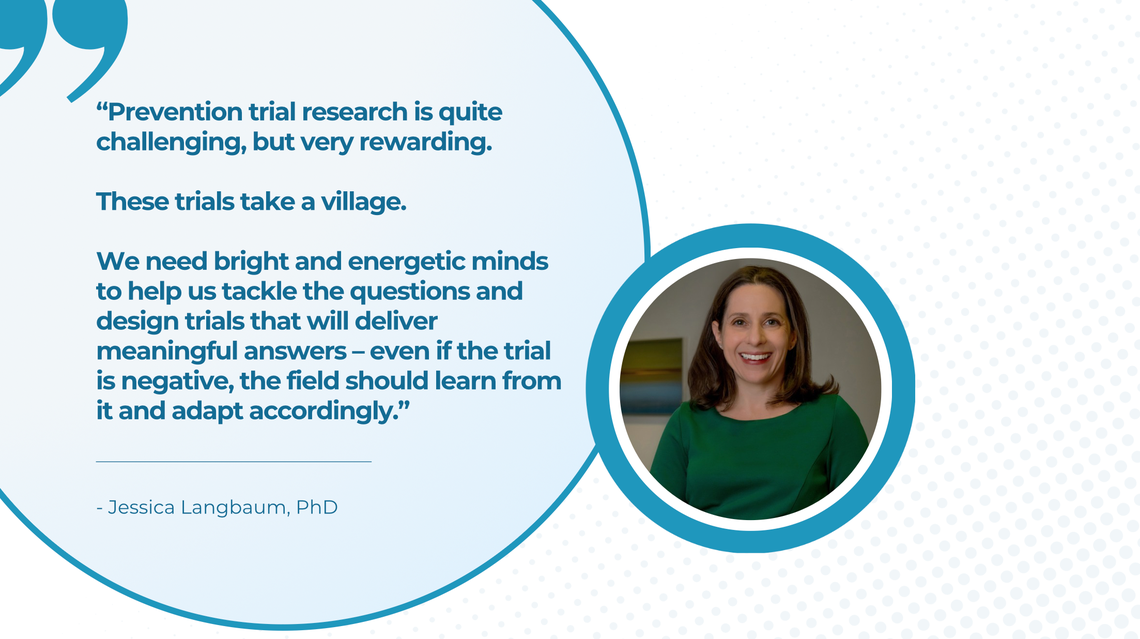As the senior director research strategy at the Banner Alzheimer’s Institute (BAI) and the director of the Arizona Alzheimer’s Disease Research Center, Dr. Jessica Langbaum’s research often centers around Alzheimer’s disease prevention trials, with an eye towards primary prevention strategies.
Her and her colleagues work designing and conducting Alzheimer’s prevention trials, especially those within the Alzheimer’s Prevention Initiative (API) – a collaborative effort established by BAI to launch a new era in Alzheimer’s prevention research and accelerate the evaluation and approval of prevention therapies -- has been pivotal in exploring how interventions might delay or prevent the onset of Alzheimer's disease in individuals at risk.
An overarching concept of this research is that “maybe if we intervene early, we can prevent the disease,” said Dr. Langbaum during an IOA Visiting Scholar Series/Penn Neurodegenerative Disease Grand Rounds lecture on “Primary and Secondary Prevention of Alzheimer’s Disease: Latest updates from the field,” at the University of Pennsylvania.
Primary vs. Secondary Prevention
Primary prevention focuses on preventing the onset of Alzheimer's disease before symptoms appear, particularly in individuals who are at risk due to genetics or family history. Dr. Langbaum's work highlights the importance of identifying individuals who are genetically predisposed to Alzheimer's, such as those with the APOE4 gene variant, and offering them interventions that might slow or halt the progression of amyloid plaque accumulation.
Primary prevention trials “may include people with certain risk factors, such as having 1 or 2 copies of the APOE4 gene (a risk factor for sporadic, late-onset Alzheimer’s), or genetic mutation that causes familial, autosomal dominant Alzheimer’s,” explained Dr. Langbaum. “The first primary prevention trials will likely focus on people at genetic risk and who have a blood biomarker test (such as pTau217) that may be on the rise, but doesn’t yet meet criteria for a “positive” test, indicative of amyloid pathology. These trials would evaluate the ability of the treatments to avert the onset of amyloid plaques.”
As for secondary prevention, this is focused on individuals without any symptoms and with one or more risk factors of the disease, such as having a genetic risk factor, and/or having biomarker evidence of disease such as having elevated brain amyloid. These trials often tend to include people with biomarker evidence of the disease who are therefore often further along in the disease continuum than those in primary prevention trials. “In these trials, the primary outcome measure is usually clinical benefit, that is, testing whether the drug slows cognitive decline or delays time progression to MCI or dementia,” Dr. Langbaum explains.
While clinical trials that have investigated the effects of amyloid-targeting treatments like anti-amyloid antibodies have had mixed results so far, there is always a takeaway. “What we’ve learned is that treatment responses were dependent on the levels of amyloid removed from the brain,” said Dr. Langbaum.

“Prevention trial research is quite challenging, but very rewarding. These trials take a village,” she says. “We need bright and energetic minds to help us tackle the questions and design trials that will deliver meaningful answers – even if the trial is negative (i.e., it doesn’t meet the primary endpoint), the field should learn from it and adapt accordingly.”
The Future of the Field
Dr. Langbaum’s research is at the forefront of shaping Alzheimer's prevention strategies. The work of her and her colleagues at BAI and within the API have advanced our understanding of Alzheimer’s disease prevention by emphasizing early detection and intervention. Although amyloid-targeting treatments have generated both hope and skepticism, the field continues to move forward with the goal of a more personalized approach. This would include refining patient selection, using biomarkers to detect early changes, and exploring combination therapies that might target multiple aspects of the disease.
“The field has made great strides recently in understanding why some anti-amyloid treatments are more effective than others, and continuing to develop safer and more effective versions of these therapies. At the same time, other approaches are moving further along in the drug development pipeline,” said Dr. Langbaum. “Between blood-biomarkers that will allow us to more easily detect and monitor changes in a person (and in a less invasive and more affordable manner than with PET or CSF), and genetic discoveries, I believe that we will eventually get to a more personalized medicine approach in which a combination of treatments are prescribed.”
To watch a recording of Dr. Langbaum’s full lecture, click here.

